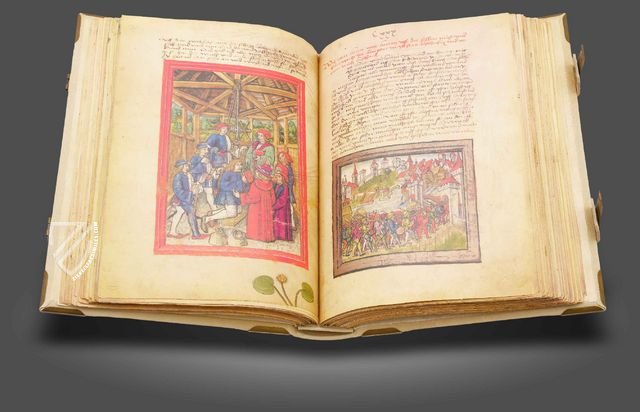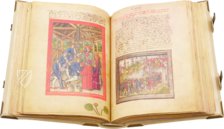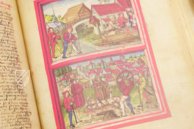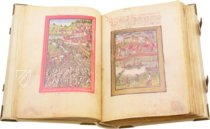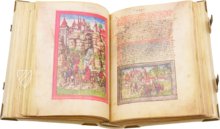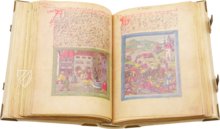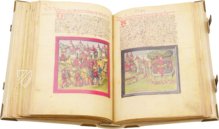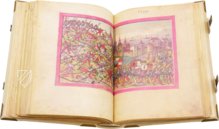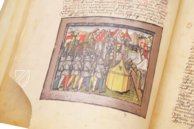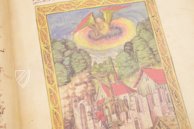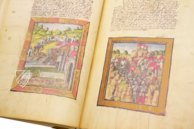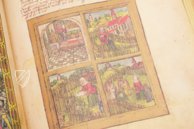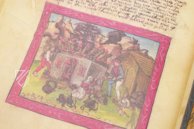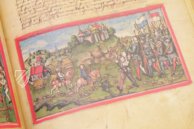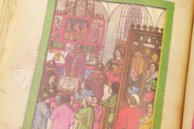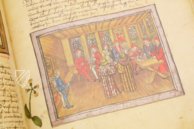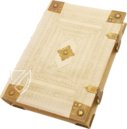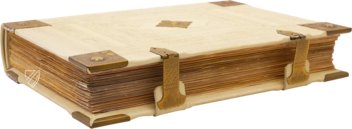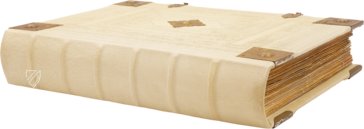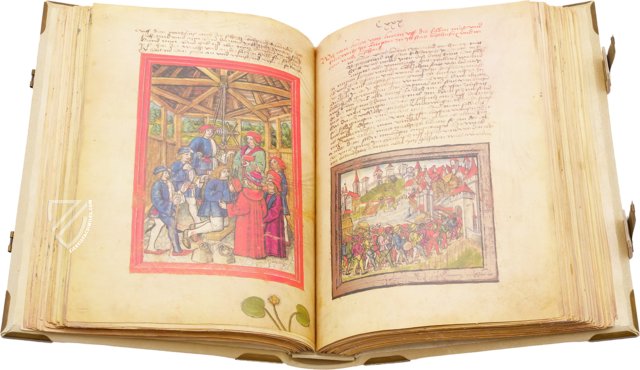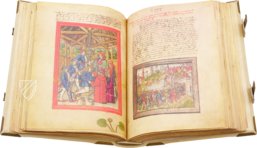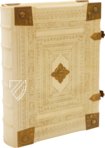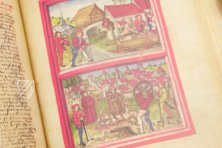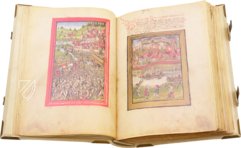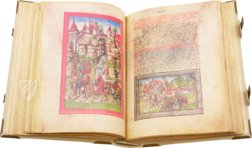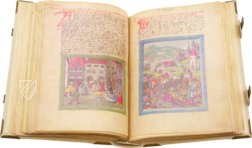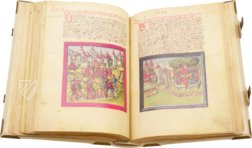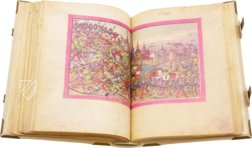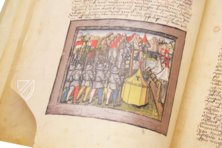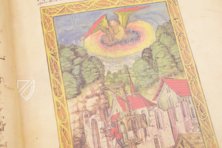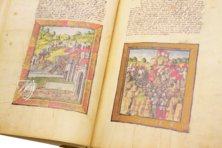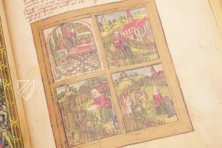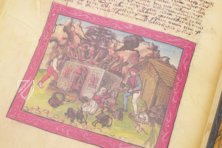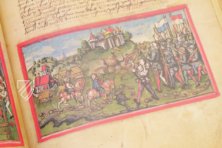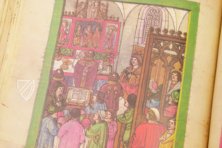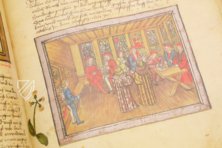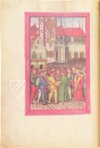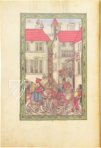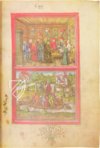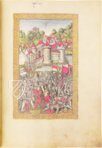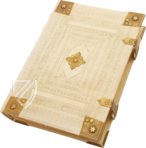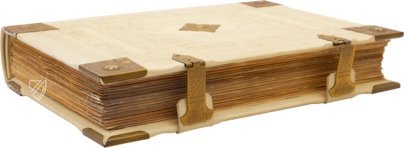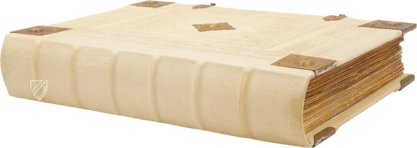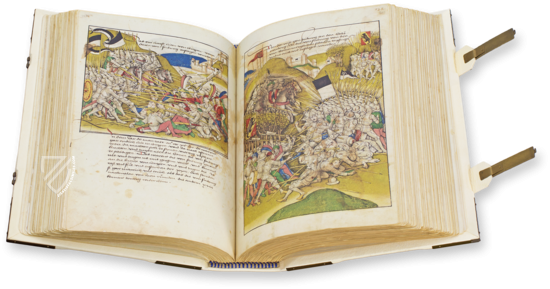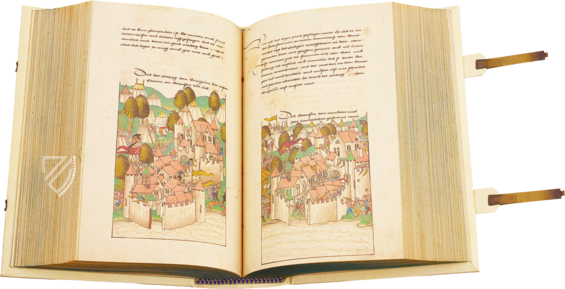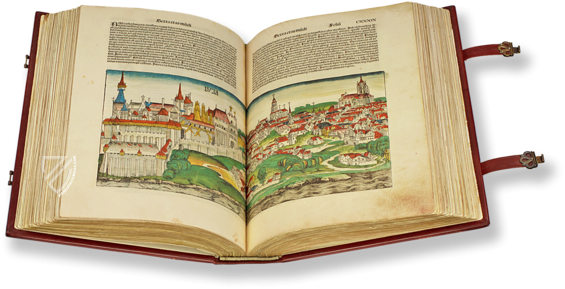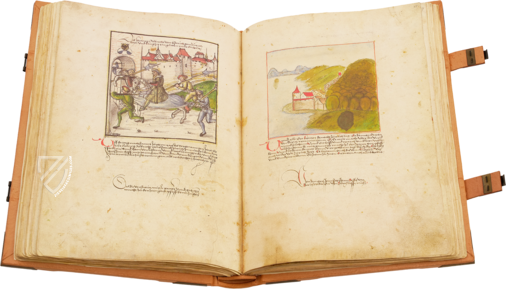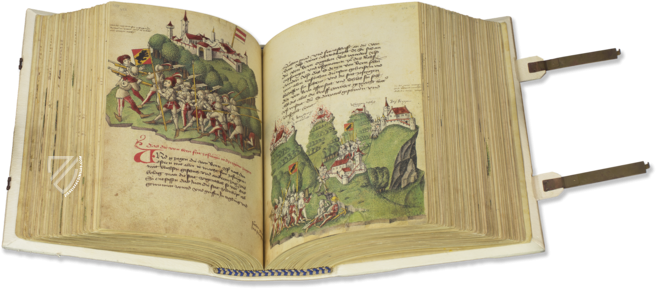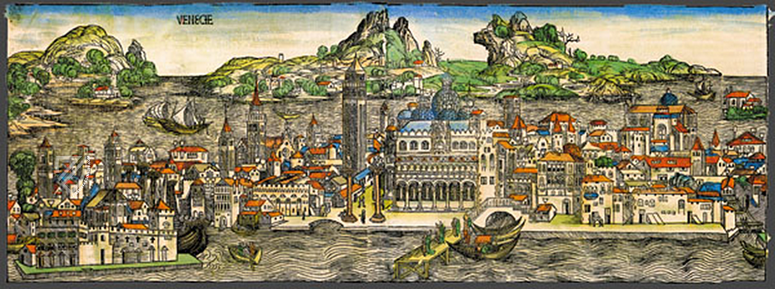Lucerne Chronicle of Diebold Schilling
(3,000€ - 7,000€)
The Lucerne Chronicle by Diebold Schilling is the most beautiful illustrated chronicle from Switzerland and represents the highpoint of the career of the famous writer and chronicler Diebold Schilling. The masterful illustrations show a sprawling variety of scenes from political, religious, and social life in the Middle Ages and allows the text of the book to step into the background.
The Lucerne Chronicle of Diebold Schilling
The Swiss chroniclers of the Late Middle Ages published a series of popular chronicles that have familiarized posterity with the political, religious, economic, and social life of the Old Swiss Confederacy. The most prominent work of this kind is the Lucerne Chronicle of Diebold Schilling the Younger. The text covers the history of the confederacy from its formation up to the year 1513. The time period of 1474–1513 is noted in particular. Relationships of political dependence stand in the foreground. The relationship of the confederates to the great powers and of the Holy Roman Emperors to the empire are debated through 443 pages. From that, only a small amount of space was used for text, which is outweighed by the impressive miniatures of the illustrated chronicle.
Two Masters of their Discipline
The text of the Lucerne Chronicle was composed by Diebold Schilling the Younger and some of the illumination is attributed to him. Schilling came from a family of some of the most experienced and talented authors of the Middle Ages. His uncle, who bore the same name, composed the world-famous Great Burgundy Chronicle. The young Diebold Schilling, who studied law in Basel, worked as a notary in Lucerne in 1479 and later went to the court of the Sforza in Milan. During this time, he began work on his illustrated chronicle of Luerne, which was probably commissioned by the authorities of Lucerne. The exact commissioner is not known. The work was completed in 1513 and was presented at a ceremonial meeting to the city council of Lucerne. The second and no less talented illuminator has remained anonymous. His miniatures differ from Schilling’s in their brushwork and color choice. This painter appears to be more experienced and already strongly influenced by Renaissance painting, while Schilling’s illustrations still stem from the unsophisticated Late Medieval style.
The Most Splendid Work of its Kind
One can safely say that the Lucerne Chronicle is the most splendidly decorated codex of the Late Middle Ages. There is no other work in which the illustrations are more meticulously and richly designed. Pictures of the most vivid colors and detail are to be found on every page. The text does not stand in the middle, as was typical, instead the text merely accompanies the image composition. Again and again, one turns to two page illustrations without text, albeit with Gothic framing, banderoles, or transcriptions that enhance the monumental effect of the images. The illustrations, which are penned in a wide variety of low-keyed colors and outlined in black, depict a sprawling plethora of people, landscapes, and buildings of all kinds. In the first volume of the chronicle, for example, the ceremonial act of presenting the work to the city council is depicted. This colorful method of depicting life at that time makes the work an enjoyable source for every historically interested reader.
Codicology
- Alternative Titles
- Luzerner Chronik des Diebold Schilling
Die Schweizer Bilderchronik des Luzerners Diebold Schilling - Size / Format
- 680 pages / 39.5 × 28.5 cm
- Origin
- Switzerland
- Date
- 1513
- Epochs
- Style
- Language
- Illustrations
- 443 illuminated pages in the Gothic and Renaissance styles
- Patron
- Probably the City Council of Lucerne
- Artist / School
- Diebold Schilling the Younger (before 1460–1515) (author)
Schilling and another unknown master (illuminators)
Lucerne Chronicle of Diebold Schilling
Punishment of Hans Hegenheim
With gorgeous colors and making skillful use of perspective, this unusual miniature does not portray a trial by ordeal but rather a form of corporal punishment called “schwemmen”. According to the text above, a youth named Hans Hegenheim was convicted of theft in 1470 and as punishment was bound with a rope, thrown into the Reuss River, and pulled behind a boat from Peterskapelle to Reusbrücke. He survived, was considered to have atoned for his crime, and went on to live a long life.
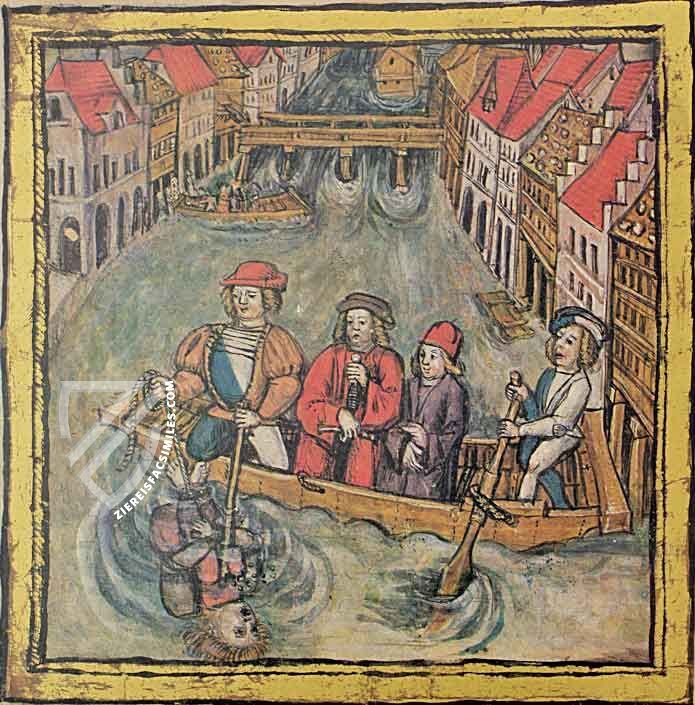
Lucerne Chronicle of Diebold Schilling
Execution of Peter von Hagenbach (1474)
Peter von Hagenbach was an Alsatian knight, military captain, and bailiff in the service of Duke Charles the Bold of Burgundy, a great enemy of the Swiss. He was the first commander held responsible for war crimes that "he as a knight was deemed to have a duty to prevent." Aside from depicting his beheading, this scene wonderfully details contemporary clothing and armor.
Hagenbach is kneeling before a priest holding a wooden crucifix, his hands folded in prayer, a red cap pulled over his eyes. The brightly-colored executioner, who puts a consoling hand on his shoulder, is a Landsknecht mercenary – a term coined by Hagenbach and perhaps a nod to some poetic justice being served. His great sword, like the rest of the weapons, shines with silver leaf.
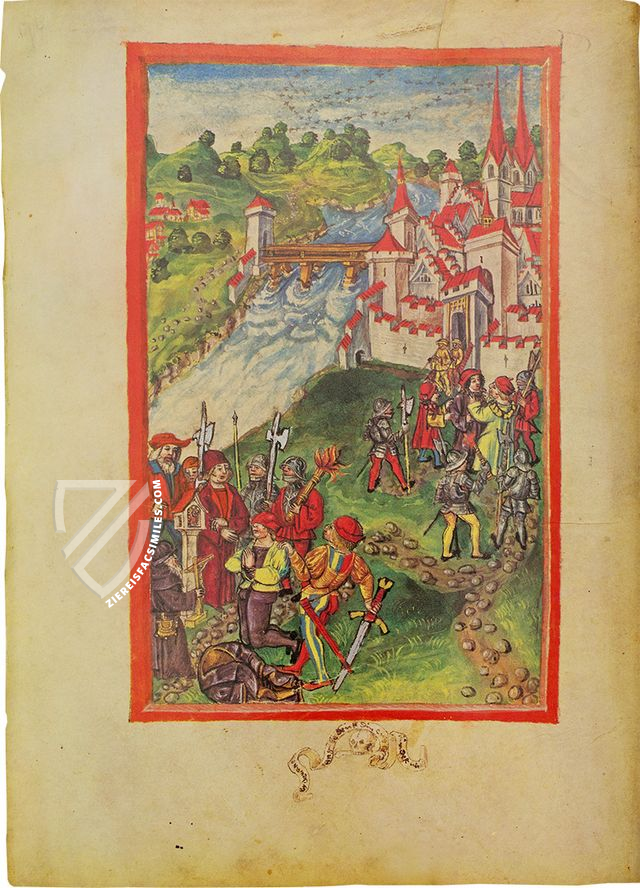
#1 Luzerner Chronik des Diebold Schilling
Language: German
(3,000€ - 7,000€)
- Treatises / Secular Books
- Apocalypses / Beatus
- Astronomy / Astrology
- Bestiaries
- Bibles / Gospels
- Chronicles / History / Law
- Geography / Maps
- Saints' Lives
- Islam / Oriental
- Judaism / Hebrew
- Single Leaf Collections
- Leonardo da Vinci
- Literature / Poetry
- Liturgical Manuscripts
- Medicine / Botany / Alchemy
- Music
- Mythology / Prophecies
- Psalters
- Other Religious Books
- Games / Hunting
- Private Devotion Books
- Other Genres
- Afghanistan
- Armenia
- Austria
- Belgium
- Belize
- Bosnia and Herzegovina
- China
- Colombia
- Costa Rica
- Croatia
- Cyprus
- Czech Republic
- Denmark
- Egypt
- El Salvador
- Ethiopia
- France
- Germany
- Greece
- Guatemala
- Honduras
- Hungary
- India
- Iran
- Iraq
- Israel
- Italy
- Japan
- Jordan
- Kazakhstan
- Kyrgyzstan
- Lebanon
- Liechtenstein
- Luxembourg
- Mexico
- Morocco
- Netherlands
- Palestine
- Panama
- Peru
- Poland
- Portugal
- Romania
- Russia
- Serbia
- Spain
- Sri Lanka
- Sweden
- Switzerland
- Syria
- Tajikistan
- Turkey
- Turkmenistan
- Ukraine
- United Kingdom
- United States
- Uzbekistan
- Vatican City
- A. Oosthoek, van Holkema & Warendorf
- Aboca Museum
- Ajuntament de Valencia
- Akademie Verlag
- Akademische Druck- u. Verlagsanstalt (ADEVA)
- Aldo Ausilio Editore - Bottega d’Erasmo
- Alecto Historical Editions
- Alkuin Verlag
- Almqvist & Wiksell
- Amilcare Pizzi
- Andreas & Andreas Verlagsbuchhandlung
- Archa 90
- Archiv Verlag
- Archivi Edizioni
- Arnold Verlag
- ARS
- Ars Magna
- ArtCodex
- AyN Ediciones
- Azimuth Editions
- Badenia Verlag
- Bärenreiter-Verlag
- Belser Verlag
- Belser Verlag / WK Wertkontor
- Benziger Verlag
- Bernardinum Wydawnictwo
- BiblioGemma
- Biblioteca Apostolica Vaticana (Vaticanstadt, Vaticanstadt)
- Bibliotheca Palatina Faksimile Verlag
- Bibliotheca Rara
- Boydell & Brewer
- Bramante Edizioni
- Bredius Genootschap
- Brepols Publishers
- British Library
- C. Weckesser
- Caixa Catalunya
- Canesi
- CAPSA, Ars Scriptoria
- Caratzas Brothers, Publishers
- Carus Verlag
- Casamassima Libri
- Centrum Cartographie Verlag GmbH
- Chavane Verlag
- Christian Brandstätter Verlag
- Circulo Cientifico
- Club Bibliófilo Versol
- Club du Livre
- CM Editores
- Collegium Graphicum
- Collezione Apocrifa Da Vinci
- Comissão Nacional para as Comemorações dos Descobrimentos Portugueses
- Coron Verlag
- Corvina
- CTHS
- D. S. Brewer
- Damon
- De Agostini/UTET
- De Nederlandsche Boekhandel
- De Schutter
- Deuschle & Stemmle
- Deutscher Verlag für Kunstwissenschaft
- DIAMM
- Droz
- E. Schreiber Graphische Kunstanstalten
- Ediciones Boreal
- Ediciones Grial
- Ediclube
- Edições Inapa
- Edilan
- Editalia
- Edition Deuschle
- Edition Georg Popp
- Edition Leipzig
- Edition Libri Illustri
- Editiones Reales Sitios S. L.
- Éditions de l'Oiseau Lyre
- Editions Medicina Rara
- Editorial Casariego
- Editorial Mintzoa
- Editrice Antenore
- Editrice Velar
- Edizioni Edison
- Egeria, S.L.
- Eikon Editores
- Electa
- Emery Walker Limited
- Enciclopèdia Catalana
- Eos-Verlag
- Ephesus Publishing
- Ernst Battenberg
- Eugrammia Press
- Extraordinary Editions
- Fackelverlag
- Facsimila Art & Edition
- Facsimile Editions Ltd.
- Facsimilia Art & Edition Ebert KG
- Faksimile Verlag
- Feuermann Verlag
- Folger Shakespeare Library
- Franco Cosimo Panini Editore
- Friedrich Wittig Verlag
- Fundación Hullera Vasco-Leonesa
- G. Braziller
- Gabriele Mazzotta Editore
- Gebr. Mann Verlag
- Gesellschaft für graphische Industrie
- Getty Research Institute
- Giovanni Domenico de Rossi
- Giunti Editore
- Graffiti
- Grafica European Center of Fine Arts
- Guido Pressler
- Guillermo Blazquez
- Gustav Kiepenheuer
- H. N. Abrams
- Harrassowitz
- Harvard University Press
- Helikon
- Hendrickson Publishers
- Henning Oppermann
- Herder Verlag
- Hes & De Graaf Publishers
- Hoepli
- Holbein-Verlag
- Houghton Library
- Hugo Schmidt Verlag
- Idion Verlag
- Il Bulino, edizioni d'arte
- ILte
- Imago
- Insel Verlag
- Insel-Verlag Anton Kippenberger
- Instituto de Estudios Altoaragoneses
- Instituto Nacional de Antropología e Historia
- Introligatornia Budnik Jerzy
- Istituto dell'Enciclopedia Italiana - Treccani
- Istituto Ellenico di Studi Bizantini e Postbizantini
- Istituto Geografico De Agostini
- Istituto Poligrafico e Zecca dello Stato
- Italarte Art Establishments
- Jan Thorbecke Verlag
- Johnson Reprint Corporation
- Josef Stocker
- Josef Stocker-Schmid
- Jugoslavija
- Karl W. Hiersemann
- Kasper Straube
- Kaydeda Ediciones
- Kindler Verlag / Coron Verlag
- Kodansha International Ltd.
- Konrad Kölbl Verlag
- Kurt Wolff Verlag
- La Liberia dello Stato
- La Linea Editrice
- La Meta Editore
- Lambert Schneider
- Landeskreditbank Baden-Württemberg
- Leo S. Olschki
- Les Incunables
- Liber Artis
- Library of Congress
- Libreria Musicale Italiana
- Lichtdruck
- Lito Immagine Editore
- Lumen Artis
- Lund Humphries
- M. Moleiro Editor
- Maison des Sciences de l'homme et de la société de Poitiers
- Manuscriptum
- Martinus Nijhoff
- Maruzen-Yushodo Co. Ltd.
- MASA
- Massada Publishers
- McGraw-Hill
- Metropolitan Museum of Art
- Militos
- Millennium Liber
- Müller & Schindler
- Nahar - Stavit
- Nahar and Steimatzky
- National Library of Wales
- Neri Pozza
- Nova Charta
- Oceanum Verlag
- Odeon
- Orbis Mediaevalis
- Orbis Pictus
- Österreichische Staatsdruckerei
- Oxford University Press
- Pageant Books
- Parzellers Buchverlag
- Patrimonio Ediciones
- Pattloch Verlag
- PIAF
- Pieper Verlag
- Plon-Nourrit et cie
- Poligrafiche Bolis
- Presses Universitaires de Strasbourg
- Prestel Verlag
- Princeton University Press
- Prisma Verlag
- Priuli & Verlucca, editori
- Pro Sport Verlag
- Propyläen Verlag
- Pytheas Books
- Quaternio Verlag Luzern
- Reales Sitios
- Recht-Verlag
- Reichert Verlag
- Reichsdruckerei
- Reprint Verlag
- Riehn & Reusch
- Roberto Vattori Editore
- Rosenkilde and Bagger
- Roxburghe Club
- Salerno Editrice
- Saltellus Press
- Sandoz
- Sarajevo Svjetlost
- Schöck ArtPrint Kft.
- Schulsinger Brothers
- Scolar Press
- Scrinium
- Scripta Maneant
- Scriptorium
- Shazar
- Siloé, arte y bibliofilia
- SISMEL - Edizioni del Galluzzo
- Sociedad Mexicana de Antropología
- Société des Bibliophiles & Iconophiles de Belgique
- Soncin Publishing
- Sorli Ediciones
- Stainer and Bell
- Studer
- Styria Verlag
- Sumptibus Pragopress
- Szegedi Tudomànyegyetem
- Taberna Libraria
- Tarshish Books
- Taschen
- Tempus Libri
- Testimonio Compañía Editorial
- Thames and Hudson
- The Clear Vue Publishing Partnership Limited
- The Facsimile Codex
- The Folio Society
- The Marquess of Normanby
- The Richard III and Yorkist History Trust
- Tip.Le.Co
- TouchArt
- TREC Publishing House
- TRI Publishing Co.
- Trident Editore
- Tuliba Collection
- Typis Regiae Officinae Polygraphicae
- Union Verlag Berlin
- Universidad de Granada
- University of California Press
- University of Chicago Press
- Urs Graf
- Vallecchi
- Van Wijnen
- VCH, Acta Humaniora
- VDI Verlag
- VEB Deutscher Verlag für Musik
- Verlag Anton Pustet / Andreas Verlag
- Verlag Bibliophile Drucke Josef Stocker
- Verlag der Münchner Drucke
- Verlag für Regionalgeschichte
- Verlag Styria
- Vicent Garcia Editores
- W. Turnowski Ltd.
- W. Turnowsky
- Waanders Printers
- Wiener Mechitharisten-Congregation (Wien, Österreich)
- Wissenschaftliche Buchgesellschaft
- Wissenschaftliche Verlagsgesellschaft
- Wydawnictwo Dolnoslaskie
- Xuntanza Editorial
- Zakład Narodowy
- Zollikofer AG

